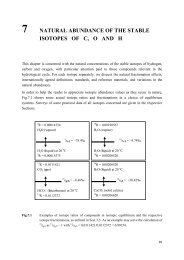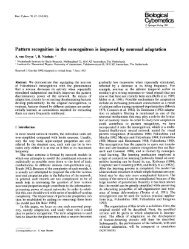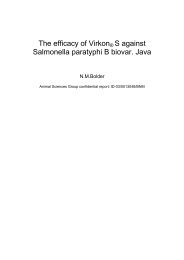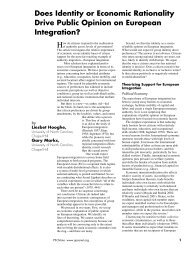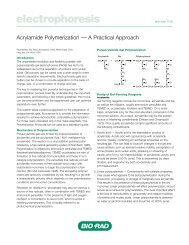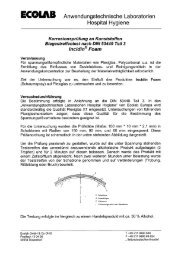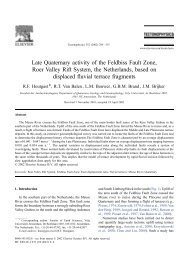DON'T PANIC - falw.vu
DON'T PANIC - falw.vu
DON'T PANIC - falw.vu
You also want an ePaper? Increase the reach of your titles
YUMPU automatically turns print PDFs into web optimized ePapers that Google loves.
A GUIDE TO DGGE (V2) Page 14<br />
run time of 17 hr (essentially overnight) at 100 V produces high quality gels for many PCR<br />
fragments. The exact voltage may differ between PCR product size, buffer concentration, buffer<br />
temperature, run time, and gel acrylamide percentage. For very short fragments, it may be<br />
important to use relatively low voltages for a long run to avoid having the fragments migrate out<br />
of the bottom of the gel. For gels in which the fragments completely stop within the gradient,<br />
extra run time will probably not effect the final gel. It seems that Volt-Hours are probably the<br />
best thing to consider. We used to run some gels at 250 V for 3 hr and found 17 hrs at 100 V<br />
yielded better gels; the 100V run had 1700 volt-hrs while the 250 V run had only 750. It should<br />
be noted that if you are particularly worried about running your fragments out of the gel, there<br />
may be a problem with your gradient (i.e. not wide enough) or your acrylamide concentration<br />
(not high enough). Every user will have a preferred voltage and run time, so I am not going to<br />
make any absolute recommendations here – there appear to be many possible conditions which<br />
yield good results. Many times the conditions will have to be empirically determined.<br />
INITIAL VOLTAGE VALUES<br />
Some users will run a high voltage initially to bring the DNA into the gel and then use a lower<br />
voltage for the rest of the run. In the Ingeny system, one is supposed to run the gel for a little<br />
while to draw the DNA into the gel before turning on the recirculating pump – otherwise the<br />
pump may stir up the PCR product in each well. I do not think that running an initial high<br />
voltage is important; the critical factor is to have the temperature stabilized. With the Bio-Rad,<br />
you have to keep removing the heating element from the tank and during the cleaning of the<br />
wells and loading of samples, the buffer cools down. Before starting the electrophoresis, you<br />
should make sure that the temperature of the tank is at 60C (or whatever temperature you are<br />
using). You can run a low voltage while the tank is heating to its final temperature just so you<br />
limit diffusion of the DNA into adjacent wells. The important thing is to not let the DNA<br />
migrate into the gradient until the buffer is at the correct temperature.<br />
AMPERES VS VOLTS<br />
I have seen a lot of discussion about voltage vs amperage when dealing with electrophoresis.<br />
You could run your electrophoresis with either fixed voltage or amperage, but the standard<br />
appears to be constant voltage. I have found that when running gels with a fixed voltage, the<br />
resulting amperage is an excellent indicator for problems with the system. Old buffer, leaks in<br />
the system, air bubble blocking the bottom of the gel, poor circulation, temperature – all these<br />
factors can affect the operation of the system and these will show up in the amperage – usually<br />
by low amperage relative to a well operating system. For example, on my Ingeny DGGE system,<br />
I can expect approximately 40 mA when running a single gel at 100V, 60C. To make sure my<br />
system is properly set up prior to loading samples, I run a few minutes of electricity through the<br />
system at 100V to make sure I get 40 mA (obviously each system will have a different<br />
“standard” mA value at a fixed voltage). If the values are way off I know there is some sort of<br />
problem. I never load my samples until the mA values are within proper ranges. You should also<br />
remember that at the same voltage, running 2 gels will yield a higher mA than running 1 gel.<br />
Regardless of how many gels you are running, you should maintain the same voltage. If your gel<br />
box cannot handle the amperage from multiple gels, you may have to run at a lower voltage for a<br />
longer time.<br />
Stefan J. Green Stefan@stefangreen.com



